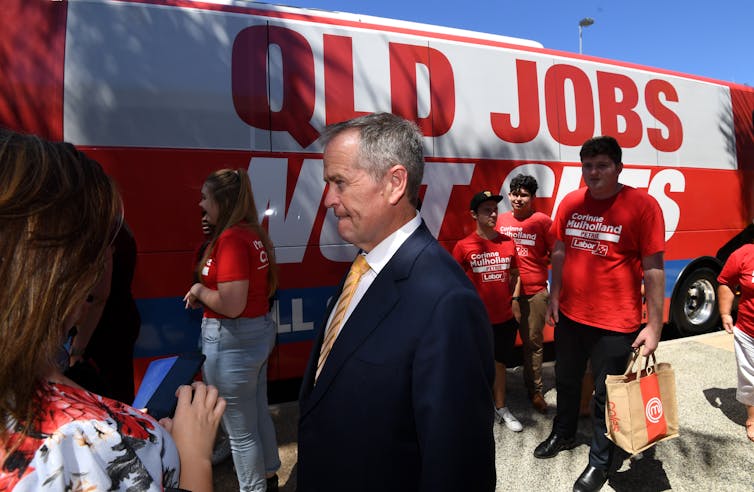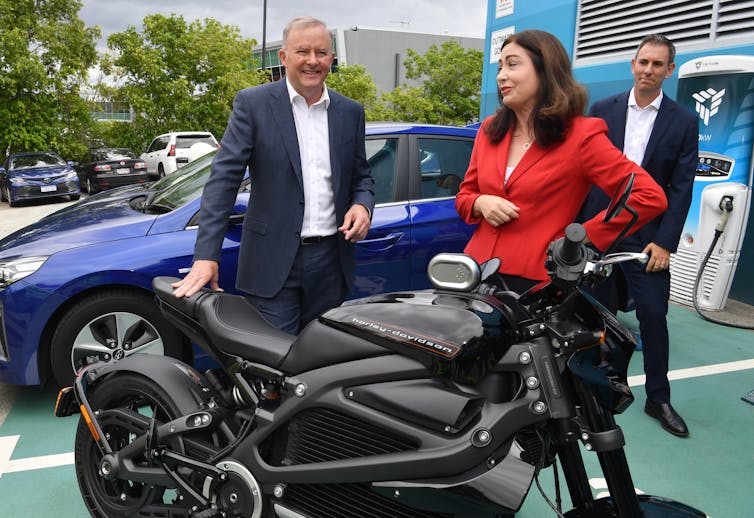How to win back Queensland
- Written by Chris Wallace, Associate Professor, 50/50 By 2030 Foundation, Faculty of Business Government & Law, University of Canberra
Federal opposition leader Anthony Albanese’s recent six-day tour[1] of Queensland came not a minute too soon for Labor’s prospects in the possible[2] election year of 2021.
The old adage that you can’t win an election without winning Queensland was proven roundly by ex-Labor leader Bill Shorten’s performance in 2019[3]. Albanese knows the party has to pick up at least three or four Queensland seats to have any hope of dislodging the Coalition government.
The smoking ruin of 2019
The scale of Labor’s 2019 Queensland disaster[4] bears close inspection.
With a primary vote of just 26.7%, Labor won only six out of thirty Queensland seats. This was the party’s worst House of Representatives result since the Dismissal[5] election of 1975 when it was left with just one.
 Labor only managed to secure one in five lower house seats in Queensland under Bill Shorten. Dan Peled/AAP
Labor only managed to secure one in five lower house seats in Queensland under Bill Shorten. Dan Peled/AAP
Only one Labor senator (newcomer Nita Green) was elected — the party’s worst upper house performance in Queensland since the current Senate voting system was established in 1949.
The Australian Election Study shows the 4.3% swing[6] against Labor in Queensland was almost four times the Australian average. It also gave the Coalition an extra two lower house seats — enough to win the election.
But Queenslanders do vote Labor
Juxtapose this with Queensland Labor premier Annastacia Palaszczuk’s third consecutive state election win in 2020 and you can see Labor is not inherently the problem.
A large number of Queenslanders voted against Shorten in 2019 and for Palaszczuk in 2020.
Read more: 'Three-peat Palaszczuk': why Queenslanders swung behind Labor in historic election[7]
So Labor can, has and does win resoundingly in the sunshine state. Labor’s job now is to win back the Queenslanders lost in 2019, substantially build on their numbers, and bring in enough seats to underwrite victory.
On five of the last seven occasions Labor won a federal election, it won a majority of seats in Queensland. Today, that means Labor would have to pick up another ten seats to take its current tally of six seats to 16 out of the current 30 lower house seats.
Internal party hopes to pick up at least three or four seats, rather than ten, shows how low is the bar Labor has set itself for the coming poll.
A September poll?
Shorten did not engage[8] Queenslanders much. The question is, can Albanese succeed where Shorten failed? This is especially so with voters in outer-suburban Brisbane, in the suburbs of regional cities, and in the regions generally, who turned so savagely against federal Labor in 2019.
Key will be whether Albanese can convince Queenslanders he will act in their interests, rather than straddle the barbed wire fence Shorten did on resource sector jobs and the environment. On this, Albanese has to bring regional voters with him, while holding onto environmentally-motivated inner-city ones.
Read more: Albanese is running out of time to solve Labor's climate crisis. He needs a plan that works for two Australias[9]
Albanese knows he cannot win unless he can convince Queenslanders on both jobs and the environment, and his recent frontbench reshuffle[10] was designed with this in mind. Deputy leader Richard Marles, now shadow minister for reconstruction, employment, skills and small business, and Chris Bowen, shadow minister for climate change and energy, will be expected to deliver on the policy and politics of this challenge.
They don’t have a lot of time. The government will likely want to capitalise on the popularity of the upcoming COVID-19 vaccine roll out[11], and get in ahead of voter unhappiness at the withdrawal of pandemic stimulus benefits[12], by calling an early election.
With a September 2021 poll widely expected in Canberra, despite Prime Minister Scott Morrison’s protestations to the contrary[13], the opposition leader urgently needs Queenslanders to get to know him better and vice versa.
Getting to know you
The COVID-19 pandemic has made it difficult for Albanese to go to Queensland over the past year.
Albanese has to flesh himself out. He has to spend a lot of time in Queensland projecting, as the new Labor slogan[14] has it, he’s “on their side”.
 Last week, Anthony Albanese was joined on the pre-campaign trail by several frontbenchers, including Terri Butler and Jim Chalmers. Darren England/AAP
Last week, Anthony Albanese was joined on the pre-campaign trail by several frontbenchers, including Terri Butler and Jim Chalmers. Darren England/AAP
In his six-day visit to Queensland, Albanese spruiked Labor’s new industrial relations policy[15] with the discipline necessary for a winning leader. Its focus on the situation of marginal and gig economy workers has potential appeal for one of the kinds of voters Labor needs to connect with, providing Albanese can garner their attention for long enough to hear him.
It will become clear in coming months whether Albanese can do the theatre of politics well enough to cut through with initiatives like this and make inroads for Labor.
Read more: Anthony Albanese's plan to boost protections for Australians in insecure work[16]
Excellent initiatives in his 2020 budget reply speech[17] on childcare, industry and energy policy disappeared like water into sand. It’s no good having the policies if you can’t communicate them and make them stick in voters’ minds.
The Queensland opportunity
The flipside of Labor’s woeful 2019 result is it would be hard for anyone to do worse at the next poll. Queensland now represents an enormous opportunity. If Albanese can turn it around for Labor there, he can win the next election.
That possibility is greater than many people may realise. It is unusual for a prime minister to campaign hard[18] for a state counterpart — as Morrison did for the Liberal National Party in Queensland last year — only for that state leader to go down in a comprehensive loss[19].
Read more: How to win an election? Do the substance as well as the theatre of politics[20]
Morrison’s inability to help then Queensland LNP leader Deb Frecklington stop Palaszczuk’s emphatic win shows there are limits to his political cleverness and appeal. After warming to him relative to Shorten in 2019, voters there revealed a new scepticism about Morrison in 2020.
But Albanese has a lot of work to do to convince Queenslanders he is worthy of their vote. The more time he spends there, the better, and his latest trip was a good down-payment on that task.
If his approach works, opinion polls will move in Labor’s favour and the party’s marginal seat-holders around Australia will start to breathe easier.
References
- ^ six-day tour (www.skynews.com.au)
- ^ possible (www.smh.com.au)
- ^ performance in 2019 (theconversation.com)
- ^ Queensland disaster (theconversation.com)
- ^ the Dismissal (theconversation.com)
- ^ 4.3% swing (australianelectionstudy.org)
- ^ 'Three-peat Palaszczuk': why Queenslanders swung behind Labor in historic election (theconversation.com)
- ^ did not engage (www.abc.net.au)
- ^ Albanese is running out of time to solve Labor's climate crisis. He needs a plan that works for two Australias (theconversation.com)
- ^ recent frontbench reshuffle (theconversation.com)
- ^ vaccine roll out (theconversation.com)
- ^ withdrawal of pandemic stimulus benefits (www.abc.net.au)
- ^ protestations to the contrary (thenewdaily.com.au)
- ^ new Labor slogan (www.theguardian.com)
- ^ new industrial relations policy (theconversation.com)
- ^ Anthony Albanese's plan to boost protections for Australians in insecure work (theconversation.com)
- ^ 2020 budget reply speech (www.theguardian.com)
- ^ campaign hard (www.abc.net.au)
- ^ comprehensive loss (theconversation.com)
- ^ How to win an election? Do the substance as well as the theatre of politics (theconversation.com)
Read more https://theconversation.com/labors-wicked-problem-how-to-win-back-queensland-154951













